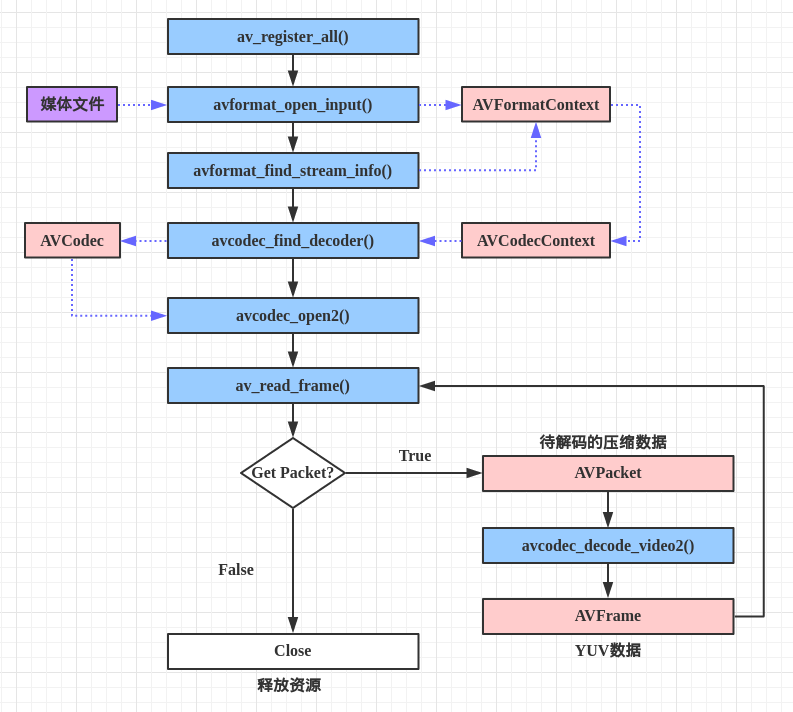生成缩略图的步骤
- 使用ffmpeg解码视频
- 帧格式转换
- 根据缩略图的数量从视频流中取帧
- 使用opencv建立画布并生成缩略图
ffmpeg解码视频

根据缩略图的数量从视频流中取帧
- 获取图片之间的时间间隔
1
2
3
4
5
6
7
8
9
10
11
12
13
14
15
16
17// Read media file and read the header information from container format
AVFormatContext* pFormatContext = avformat_alloc_context();
if (!pFormatContext) {
logging("ERROR could not allocate memory for format context");
return -1;
}
if (avformat_open_input(&pFormatContext, inputFilePath.string().c_str(), NULL, NULL) != 0) {
logging("ERROR could not open media file");
}
logging("format %s, duration %lld us, bit_rate %lld", pFormatContext->iformat->name, pFormatContext->duration, pFormatContext->bit_rate);
cout << "视频时常:" << pFormatContext->duration / 1000.0 / 1000.0 << "s" << endl;
int64_t video_duration = pFormatContext->duration;
int sum_count = rowNums * colNums;
//跳转的间隔 ms
int64_t time_step = video_duration / sum_count / 1000; - 设置跳转时间获取不同的视频Packet
1
2
3
4
5
6
7
8
9
10
11
12
13
14
15
16for (int i = 0; i < sum_count ; ++i) {
cv::Mat tempImage;
// 每次读取相同时间间隔的图像并存入vImage中
while (av_read_frame(pFormatContext, pPacket) >= 0) {
if (pPacket->stream_index == video_stream_index) {
response = decode_packet_2mat(pPacket, pCodecContext, pFrame, tempImage);// 返回
}
if (response == 0)// 成功读取一帧
break;
if (response < 0)
continue;
}
vImage.push_back(tempImage);
// 跳转视频
av_seek_frame(pFormatContext, -1, ((double)time_step / (double)1000)* AV_TIME_BASE*(double)(i+1) + (double)pFormatContext->start_time, AVSEEK_FLAG_BACKWARD);
} - 获取Frame
在固定的时间点可能无法获取从当前时间点的Packet获取对应的Frame,所以需要对获取的Packet进行判断,如果没有获取到对应的Frame应该继续获取下一Packet直到获取到对应的Frame为止。1
2
3
4
5
6
7
8
9
10
11
12
13
14
15
16
17
18
19
20
21
22
23
24
25
26
27static int decode_packet_2mat(AVPacket* pPacket, AVCodecContext* pCodecContext, AVFrame* pFrame, cv::Mat& image) {
int response = avcodec_send_packet(pCodecContext, pPacket);
if (response < 0) {
logging("Error while sending a packet to the decoder");
return response;
}
while (response >= 0) {
// return decoded out data from a decoder
response = avcodec_receive_frame(pCodecContext, pFrame);
if (response == AVERROR(EAGAIN) || response == AVERROR_EOF) {
logging("averror averror_eof");
break;
}
else if (response < 0) {
logging("Error while receiving frame");
return response;
}
if (response >= 0) {
// 获取到Frame
image = frame2Mat(pFrame, pCodecContext->pix_fmt);
}
return 0;
}
}帧格式转换
由于从视频流获取的帧是YUV格式的Frame格式,后面使用opencv进行操作所以进行格式转换。
先使用ffmpeg中的SwsContext将从视频中抽取到的帧从YUV转换到BGR格式,再从BGRFrame中的内存中获取原始数据,并转换到opencv的Mat类型。
1 | cv::Mat frame2Mat(AVFrame* pFrame, AVPixelFormat pPixFormat) |
使用opencv建立画布并生成缩略图
通过画布需要的大小参数,画出白色画布,再对画布进行填充。
1 | cv::Mat makeThumbnail(vector<cv::Mat> vImage, const unsigned int rowNums, const unsigned int colNums) |
最后的效果
